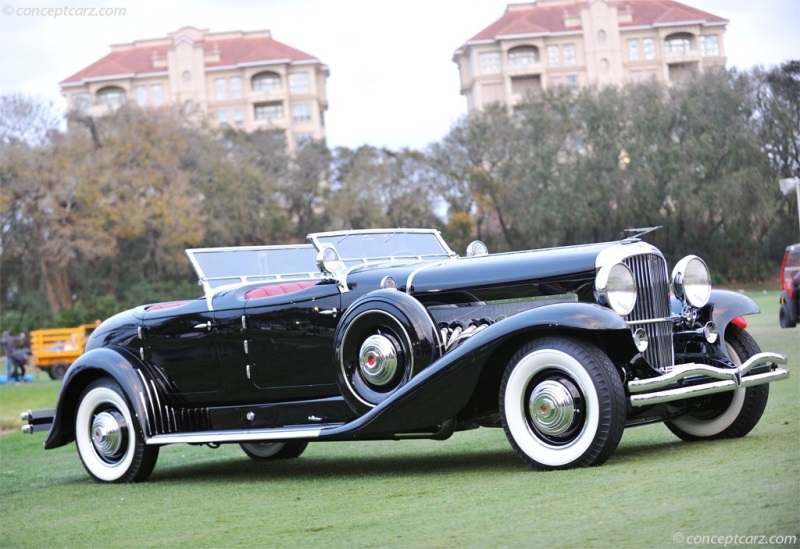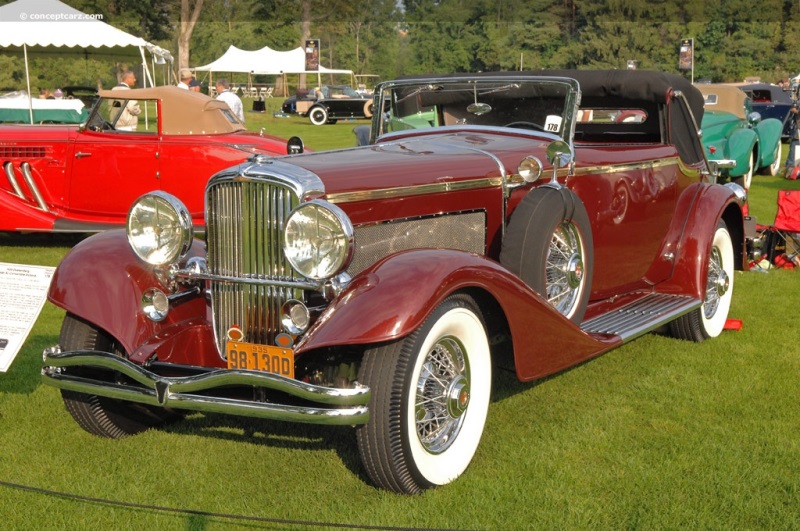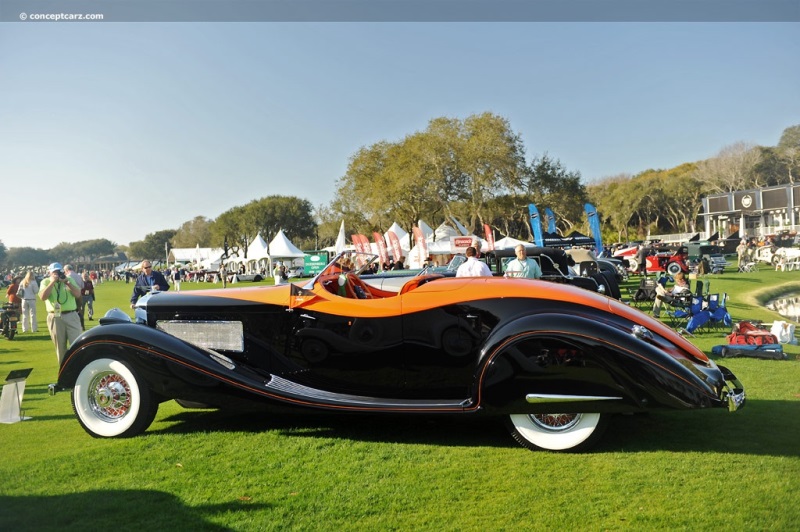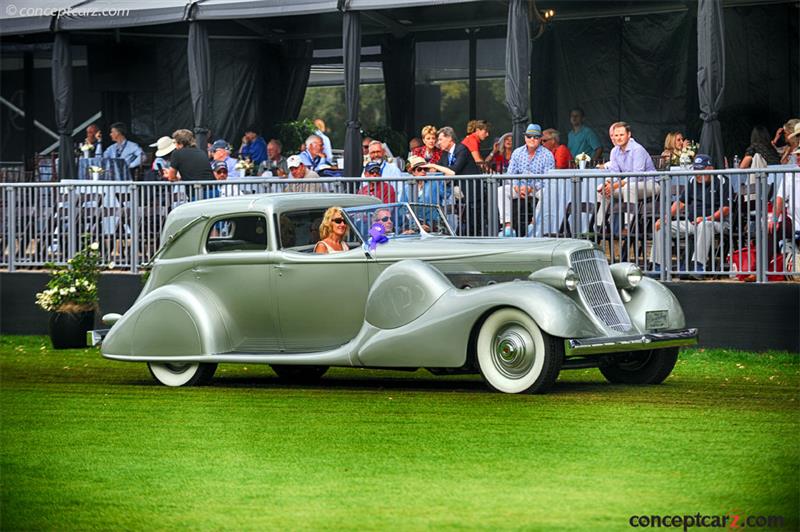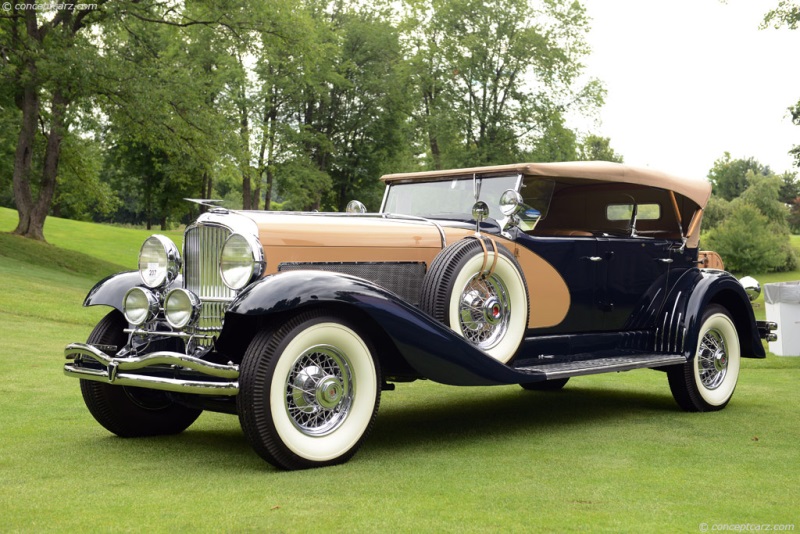The Duesenberg Model J is considered the pinnacle of Classic Era American automotive excellence. It was a paragon of precision engineering, coachbuilt elegance, unequaled performance, and Herculean proportions. Introduced in December 1928 at the New York Auto Salon, early promotional material declared the Model J as 'The World's Finest Motor Car,' challenging Cadillac's slogan of being 'the Standard of the World' and Rolls-Royce's claim of making 'the best car in the world.' 
Speedster by Gurney Nutting
Chassis #: 2614
Engine #: J-585
View info and historyGenesis
The Duesenberg Model J was the first model produced under the ownership of E.L. Cord. The company's history, however, extends much farther back, with its genesis overseen by brothers Fred and August Duesenberg. Founded in Indianapolis, Indiana, in 1920, it quickly ascended to the pinnacle of motorsport competition and luxury car manufacturing courtesy of the Duesenberg brothers' skill and experience. They had designed a vehicle in 1905 and formed the Mason Motor Car Company a year later with funding from Edward R. Mason in Des Moines, Iowa. Selling their stake in the company in 1912, the brothers moved to Saint Paul, Minnesota, where they established the Duesenberg Motors Company in 1913. In 1914, Eddie Rickenbacker drove a Duesenberg-designed vehicle at the Indianapolis 500 and placed tenth overall. In 1919, they sold their Saint Paul factories and moved to Indianapolis, Indiana, where they founded the Duesenberg Automobile & Motors Company. The company's Model A was powered by a 260 cubic-inch straight-eight engine, making it the largest engine in a commercially available vehicle. It was also the first production automobile fitted with four-wheel hydraulic brakes. Producing automobiles was a necessity, but motorsports was the Duesenberg brother's passion. In 1921, Jimmy Murphy drove a Duesenberg to victory at the French Grand Prix, becoming the first American car to do so. Automobiles built by Duesenberg won the Indianapolis 500 in 1922, 1924, 1925 and 1927.
Speedster by Gurney Nutting
Chassis #: 2614
Engine #: J-585
View info and historyDespite its accomplishments at the race track, the company struggled financially and entered receivership in 1924. In 1926, it was rescued by Errett Lobban Cord. Under his leadership, August's role in the passenger-car side of the business declined as his talents were redirected to designing race cars. The race car production after 1926 was an enterprise that functioned separately from the road-going cars and was built in a building segregated from the main Duesenberg plant. Fred Duesenberg was appointed vice president in charge of engineering and experimental work. August would have nothing to do with the initial design of the Model J but would contribute his engineering talents to other achievements like the supercharger used for both the Auburn and Cord motorcars. The Duesenberg brothers' expertise benefitted many early American auto manufacturers, and their four-cylinder produced Rochester-powered half a dozen marques. Among the list of accomplished drivers who drove their racing cars include Eddie Rickenbacker, Rex Mays, Peter DePaolo, Tommy Milton, Albert Guyot,
Ralph DePalma, Fred Frame, Deacon Litz, Joe Russo, Stubby Stubblefield, Jimmy Murphy, Ralph Mulford and Ab Jenkins. In 15 consecutive Indianapolis 500s, starting with their first appearance in 1913, 70 Duesenbergs competed. Thirty-two of them (46%) finished in the top 10. Eight of the top 10 cars that raced at the Indianapolis 500 in 1922 were Duesenberg-powered, including Jimmy Murphy's winner.E.L. Cord's Vision
E.L. Cord's vision for the recently acquired Duesenberg Motors Company was to create an automobile that would surpass the great marques of Europe and America. He assigned this monumental task to Fred Duesenberg, and Fred obliged, creating the Model J.The original goal was to sell 500 cars a year, but the Great Depression, nearly coinciding with its introduction, had the Model J falling far short of that mark. Approximately 200 examples had been built by October 1929, and an additional 100 orders were filled in 1930. From 1928 to 1937, a total of 481 examples were built, including 445 Model J and 36 Model SJ. The first customer delivery came in May 1929, five months before Black Tuesday. Both E.L. Cord and Auburn Corporation struggled to stay afloat in the decimated middle market, resulting in an inability to support and finance the Model J. Duesenberg properly ceased production in 1937 after Cord's financial empire collapsed. The Duesenberg Model J Mechanical Specification
The chassis of the Duesenberg Model J had a wheelbase size of nearly 12 feet and its 420 cubic-inch straight-eight engine had double overhead camshafts, four valves per cylinder, and produced 265 horsepower. In comparison, Cadillac's overhead-valve V16 engine, introduced in 1930 and having twice as many cylinders as the Duesenberg, produced 185 horsepower (80 fewer horsepower). The Duesenberg Model J had a standard wheelbase size of 142.5 inches and a longer wheelbase size of 153.5 inches. Two SSJs rested on a shortened 125-inch wheelbase platform and a few were built on a 160-inch wheelbase size. The solid front and live rear axles were suspended by semi-elliptical leaf springs and shock absorbers, and braking was done via four-wheel, two-shoe hydraulic drums. A fully automatic chassis-lubricating system operated every 30 to 60 miles.Most of the chassis and engines were constructed in 1929 and 1930, but due to the Depression, they were sold and bodied throughout subsequent years. The four-speed gearbox used by early examples was soon replaced by an unsynchronised three-speed unit subsequently fitted to all Duesenbergs. The free-breathing straight-engine engine was based on Duesenberg's racing engines of the 1920s and was manufactured by Lycoming, another company owned by Cord. It had a cast iron block and cylinder head, 5.7:1 compression, a 3.74-inch cylinder bore, a 4.76-inch piston stroke, and a 420 cubic-inch displacement size. It produced 265 horsepower in naturally aspirated configuration and 320 horsepower with the help of a supercharger. This was the highest horsepower produced by an American production car until the Chrysler 'Letter Cars' of the mid-1950s.The 'SJ' had a centrifugal supercharger and more durable steel connecting rods.Performance
During an era when most cars could not achieve 100 mph, the Duesenberg Model SJ could reach 104 miles per hour in second gear and exceed a top speed of 135 mph. Zero-to-sixty mph took around eight seconds and passed 100 mph in about 17 seconds. Without the supercharger, the Model J could reach 89 mph in 2nd gear and had a top speed of around 112 to 116 mph. Pricing
The Duesenberg Model J was the fastest and most expensive American automobile on the market. The chassis cost $8,500 (USD) until 1932, after which its price increased to $9,500. With coachwork, the total price of the Model J often ranged from $13,000 to $19,000. Two American-bodied Model Js exceeded $20,000; examples fitted with European coachwork may have been higher.A custom 1933 Duesenberg SJ with an Arlington Torpedo body by Rollston was built specifically for the 1933 Century of Progress in Chicago. It is known as the 'Twenty Grand,' reflecting its selling price. Its design was penned by Gordon Buehrig, who displayed touches of earlier Beverly Berline body style and influences from Hibbard and Darrin. The rear bodywork was similar to the Rollston-built Torpedo Phaeton.In 1980, the 'Twenty Grand' Duesenberg was named Best of Show at the Pebble Beach Concours d'Elegance. In the late eighties, the car was selected to be exhibited in Essen, Germany, as one of the 'The Ten Most Beautiful Cars in the World.'Body Design and Coachwork
Gordon Miller Buehrig was hired in 1930 as Duesenberg's chief body designer. He would later create the 1935 Auburn 851 Speedster for corporate sibling Auburn Automobile Company, as well as the Cord 810 and 812. His work was renowned for its tailored proportions and fine detail, and he is respected for viewing cars as art, as evidenced by the title of his autobiography, Rolling Sculpture.
Speedster by Gurney Nutting
Chassis #: 2614
Engine #: J-585
View info and historyApproximately half of the Model Js received coachwork devised by Buehrig and executed under the name La Grande by company branches in Chicago, New York City, Los Angeles, Philadelphia, Florida and Denver, as well as by smaller dealers. The Walter M. Murphy Body Co. in Pasadena, California, produced over 140 bodies for the Model J, more than any other body builder. A Murphy-designed body was part of the first Duesenberg offering at the Auto Salon held in New York in December 1928. Their most popular body style was the Convertible Coupe, of which sixty examples were produced with fifty-two examples mounted on the 142.5-inch platform. The most famous variation of the Murphy Convertible Coupe body was the 'disappearing top.'The list of independent US coachbuilders who created coachwork for the Model J was Holbrook, Judkins, Murphy, Le Baron, Derham, Brunn, Barker, Bohman & Schwartz, Dietrich, Willoughby, Walker, and Weymann. European coachbuilders who bodied the Duesenberg include Gurney Nutting, Saoutchik, Franay, and Fernandez et Darrin. Interior
The interior housed complete instrumentation, which included a 150-miles-per-hour speedometer, a tachometer, an altimeter, an eight-day clock with a split-second stopwatch hand, and more. Depending on specification and configuration, many Model Js received cozy armchairs, a fixed center armrest, a radio, a glove box, and a custom cabinet.The Duesenberg Model J
The Duesenberg Model J achieved E.L. Cord's vision of surpassing the great marques of Europe and America. It failed, however, to achieve the intended production figures of 500 units annually due to circumstances beyond its control, namely the collapse of the world economy. Many individuals who had the resources to purchase the Duesenberg - or other luxury automobiles - declined to do so, viewing it as poor taste when most of the American workforce was unemployed and standing in bread lines.
Speedster by Gurney Nutting
Chassis #: 2614
Engine #: J-585
View info and historyDespite the era's economic hardships, 481 examples were built, including 36 with superchargers.
by Daniel Vaughan | Dec 2023
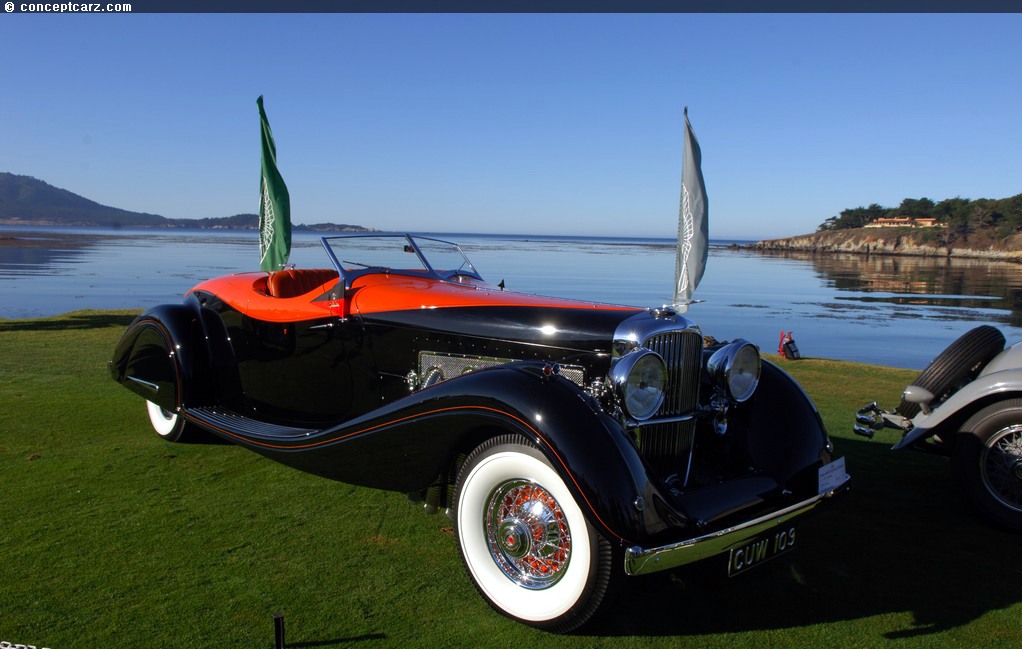
Speedster by Gurney Nutting
Chassis #: 2614
Engine #: J-585
View info and history
The Duesenberg Model J was the first model produced under the ownership of E.L. Cord. The company's history, however, extends much farther back, with its genesis overseen by brothers Fred and August Duesenberg. Founded in Indianapolis, Indiana, in 1920, it quickly ascended to the pinnacle of motorsport competition and luxury car manufacturing courtesy of the Duesenberg brothers' skill and experience. They had designed a vehicle in 1905 and formed the Mason Motor Car Company a year later with funding from Edward R. Mason in Des Moines, Iowa. Selling their stake in the company in 1912, the brothers moved to Saint Paul, Minnesota, where they established the Duesenberg Motors Company in 1913. In 1914, Eddie Rickenbacker drove a Duesenberg-designed vehicle at the Indianapolis 500 and placed tenth overall. In 1919, they sold their Saint Paul factories and moved to Indianapolis, Indiana, where they founded the Duesenberg Automobile & Motors Company. The company's Model A was powered by a 260 cubic-inch straight-eight engine, making it the largest engine in a commercially available vehicle. It was also the first production automobile fitted with four-wheel hydraulic brakes. Producing automobiles was a necessity, but motorsports was the Duesenberg brother's passion. In 1921, Jimmy Murphy drove a Duesenberg to victory at the French Grand Prix, becoming the first American car to do so. Automobiles built by Duesenberg won the Indianapolis 500 in 1922, 1924, 1925 and 1927.
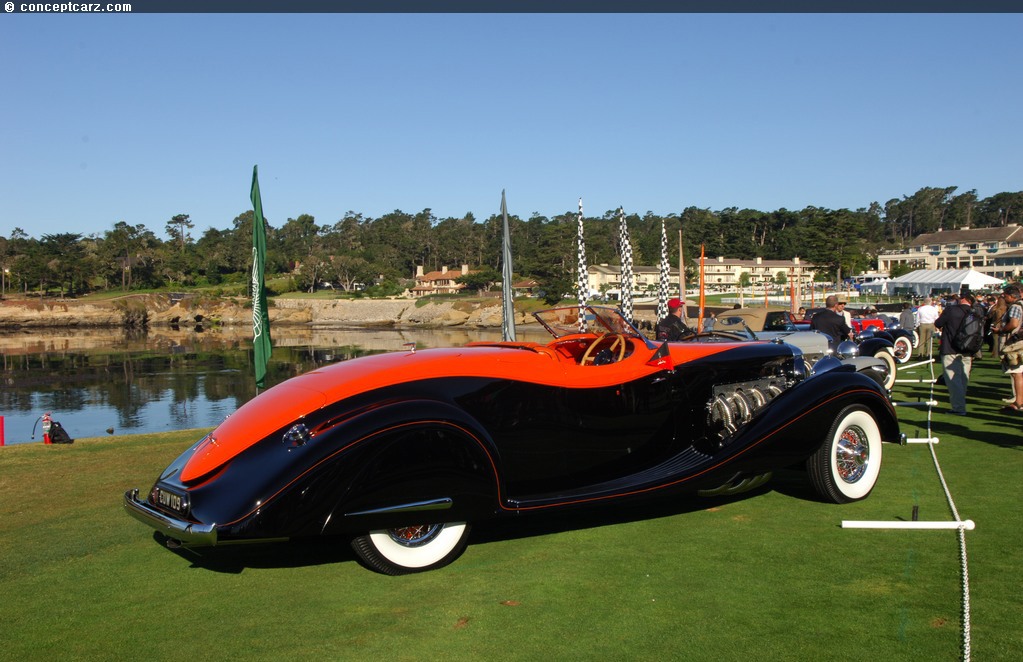
Speedster by Gurney Nutting
Chassis #: 2614
Engine #: J-585
View info and history
Ralph DePalma, Fred Frame, Deacon Litz, Joe Russo, Stubby Stubblefield, Jimmy Murphy, Ralph Mulford and Ab Jenkins. In 15 consecutive Indianapolis 500s, starting with their first appearance in 1913, 70 Duesenbergs competed. Thirty-two of them (46%) finished in the top 10. Eight of the top 10 cars that raced at the Indianapolis 500 in 1922 were Duesenberg-powered, including Jimmy Murphy's winner.E.L. Cord's Vision
E.L. Cord's vision for the recently acquired Duesenberg Motors Company was to create an automobile that would surpass the great marques of Europe and America. He assigned this monumental task to Fred Duesenberg, and Fred obliged, creating the Model J.The original goal was to sell 500 cars a year, but the Great Depression, nearly coinciding with its introduction, had the Model J falling far short of that mark. Approximately 200 examples had been built by October 1929, and an additional 100 orders were filled in 1930. From 1928 to 1937, a total of 481 examples were built, including 445 Model J and 36 Model SJ. The first customer delivery came in May 1929, five months before Black Tuesday. Both E.L. Cord and Auburn Corporation struggled to stay afloat in the decimated middle market, resulting in an inability to support and finance the Model J. Duesenberg properly ceased production in 1937 after Cord's financial empire collapsed. The Duesenberg Model J Mechanical Specification
The chassis of the Duesenberg Model J had a wheelbase size of nearly 12 feet and its 420 cubic-inch straight-eight engine had double overhead camshafts, four valves per cylinder, and produced 265 horsepower. In comparison, Cadillac's overhead-valve V16 engine, introduced in 1930 and having twice as many cylinders as the Duesenberg, produced 185 horsepower (80 fewer horsepower). The Duesenberg Model J had a standard wheelbase size of 142.5 inches and a longer wheelbase size of 153.5 inches. Two SSJs rested on a shortened 125-inch wheelbase platform and a few were built on a 160-inch wheelbase size. The solid front and live rear axles were suspended by semi-elliptical leaf springs and shock absorbers, and braking was done via four-wheel, two-shoe hydraulic drums. A fully automatic chassis-lubricating system operated every 30 to 60 miles.Most of the chassis and engines were constructed in 1929 and 1930, but due to the Depression, they were sold and bodied throughout subsequent years. The four-speed gearbox used by early examples was soon replaced by an unsynchronised three-speed unit subsequently fitted to all Duesenbergs. The free-breathing straight-engine engine was based on Duesenberg's racing engines of the 1920s and was manufactured by Lycoming, another company owned by Cord. It had a cast iron block and cylinder head, 5.7:1 compression, a 3.74-inch cylinder bore, a 4.76-inch piston stroke, and a 420 cubic-inch displacement size. It produced 265 horsepower in naturally aspirated configuration and 320 horsepower with the help of a supercharger. This was the highest horsepower produced by an American production car until the Chrysler 'Letter Cars' of the mid-1950s.The 'SJ' had a centrifugal supercharger and more durable steel connecting rods.Performance
During an era when most cars could not achieve 100 mph, the Duesenberg Model SJ could reach 104 miles per hour in second gear and exceed a top speed of 135 mph. Zero-to-sixty mph took around eight seconds and passed 100 mph in about 17 seconds. Without the supercharger, the Model J could reach 89 mph in 2nd gear and had a top speed of around 112 to 116 mph. Pricing
The Duesenberg Model J was the fastest and most expensive American automobile on the market. The chassis cost $8,500 (USD) until 1932, after which its price increased to $9,500. With coachwork, the total price of the Model J often ranged from $13,000 to $19,000. Two American-bodied Model Js exceeded $20,000; examples fitted with European coachwork may have been higher.A custom 1933 Duesenberg SJ with an Arlington Torpedo body by Rollston was built specifically for the 1933 Century of Progress in Chicago. It is known as the 'Twenty Grand,' reflecting its selling price. Its design was penned by Gordon Buehrig, who displayed touches of earlier Beverly Berline body style and influences from Hibbard and Darrin. The rear bodywork was similar to the Rollston-built Torpedo Phaeton.In 1980, the 'Twenty Grand' Duesenberg was named Best of Show at the Pebble Beach Concours d'Elegance. In the late eighties, the car was selected to be exhibited in Essen, Germany, as one of the 'The Ten Most Beautiful Cars in the World.'Body Design and Coachwork
Gordon Miller Buehrig was hired in 1930 as Duesenberg's chief body designer. He would later create the 1935 Auburn 851 Speedster for corporate sibling Auburn Automobile Company, as well as the Cord 810 and 812. His work was renowned for its tailored proportions and fine detail, and he is respected for viewing cars as art, as evidenced by the title of his autobiography, Rolling Sculpture.

Speedster by Gurney Nutting
Chassis #: 2614
Engine #: J-585
View info and history
The interior housed complete instrumentation, which included a 150-miles-per-hour speedometer, a tachometer, an altimeter, an eight-day clock with a split-second stopwatch hand, and more. Depending on specification and configuration, many Model Js received cozy armchairs, a fixed center armrest, a radio, a glove box, and a custom cabinet.The Duesenberg Model J
The Duesenberg Model J achieved E.L. Cord's vision of surpassing the great marques of Europe and America. It failed, however, to achieve the intended production figures of 500 units annually due to circumstances beyond its control, namely the collapse of the world economy. Many individuals who had the resources to purchase the Duesenberg - or other luxury automobiles - declined to do so, viewing it as poor taste when most of the American workforce was unemployed and standing in bread lines.
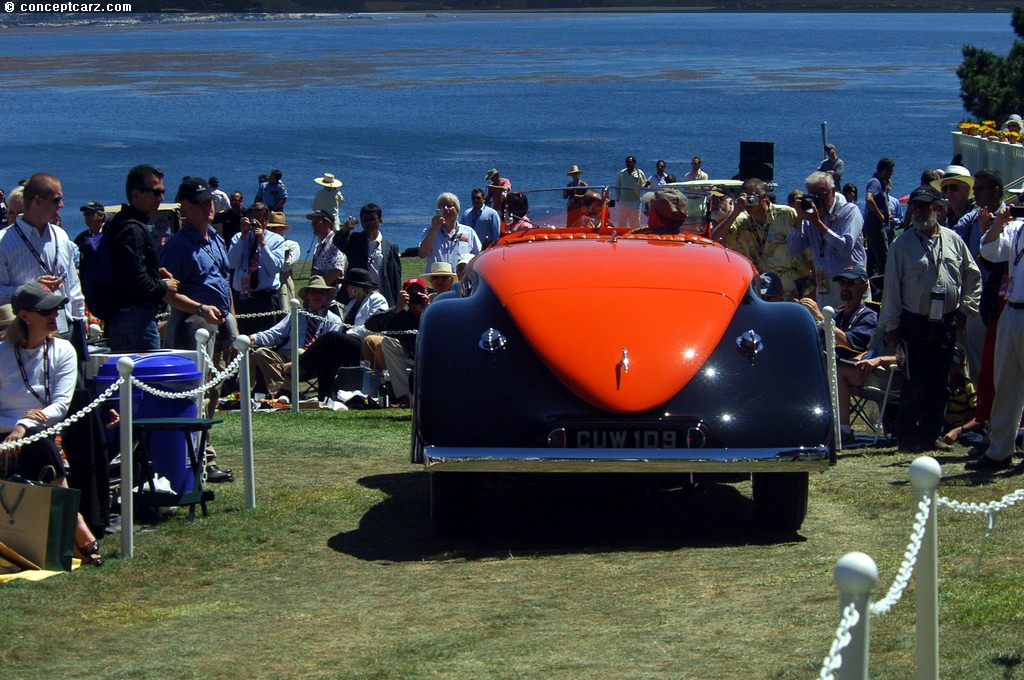
Speedster by Gurney Nutting
Chassis #: 2614
Engine #: J-585
View info and history
by Daniel Vaughan | Dec 2023
Background
The Duesenberg Company produced high-end, luxury automobiles and racing cars from 1913 through 1937. It was created by the Duesenberg brothers, Fred and August, who formed the Duesenberg Automobile %26 Motors Company, Inc. in Des Moines, Iowa with the intent on building sports cars. Just like many of their time, they were mostly self-taught engineers and had only constructed experimental cars up to....
Continue Reading >>
Continue Reading >>
1935 Duesenberg Model SJ Vehicle Profiles
Sweep Panel Dual-Cowl Phaeton
Coachwork: LaGrande
Designer: Gordon Buehrig
Chassis #: 2552
Engine #: J-523
Recent Vehicle Additions
Performance and Specification Comparison
Model SJ Specification Comparison by Year
Year
Production
Wheelbase
Engine
Prices
Related Automotive News

Amelia Island Concours Best of Show
The 2017 Amelia Island Concours dElegance Best of Show was awarded to a 1935 Duesenberg SJ owned by Terence Adderley of Bloomfields Hills, Mi.
The Model J was produced in Indianapolis from 1929 until 1937 with a 420 cubic-inch DOHC engine producing...

Past Best of Show Winners at The Pebble Beach Concours d'Elegance
overview1
The 70th anniversary of the Pebble Beach Concours dElegance was celebrated with a spectacular display of previous Best of Show winners. Thirty-seven examples graced the showfield and many were still with the same owners who raised the trophy...

Alfa Romeo Named Best of Show at the 68th Pebble Beach Concours d'Elegance
Touring-Bodied Alfa Romeo 8C 2900B Named Best of Show at the 68th Pebble Beach Concours dElegance
PEBBLE BEACH, Calif. (August 26, 2018) — After an intense competition that drew diverse cars from around the globe, the coveted gold Best of Show...

1929 Mercedes-Benz S Barker Tourer Named Best Of Show At The 67Th Pebble Beach Concours d'Elegance
PEBBLE BEACH, Calif. (August 20, 2017) — Just a week ago, Bruce R. McCaws 1929 Mercedes-Benz S Barker Tourer emerged from the restoration shop of Steve Babinsky in Lebanon, New Jersey. Today, having crossed the country, the boattailed beauty captured...

Lancia Named 2016 Best of Show
PEBBLE BEACH, Calif. (August 21, 2016) — The 2016 Pebble Beach Concours dElegance concluded with first-time entrant Richard Mattei lifting the top prize high overhead soon after his 1936 Lancia Astura Pinin Farina Cabriolet was named Best of...
HPD UNVEILS STREET PERFORMANCE PRODUCTS AT 2013 SEMA SHOW
11052013 - LAS VEGAS Long a fixture at race circuits around the world, Honda Performance Development, the racing arm of American Honda Motor Co., Inc., will now be offering a new range of HPD Street Performance products, starting with the Honda...






























